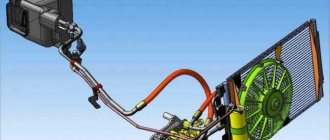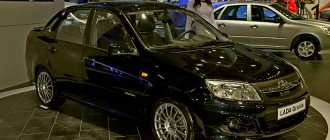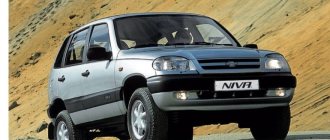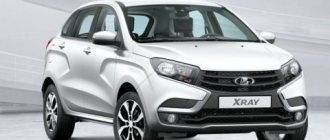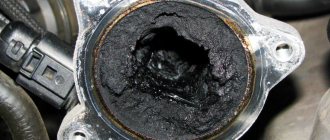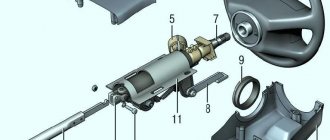VAZ-2131 is a five-door Lada 4x4 SUV, which until 2006 had the designation “Niva”. The car entered the production line in 1993, and is built on the basis of the three-door Lada 4×4. On the Russian market, version 2131 is less in demand than the three-door model. But despite this, by 2009 the production of the hundred thousandth copy of Lada 4×4 2131 took place. During its assembly line life, the car received a number of improvements, but structurally never changed. At one time, the five-door SUV was in demand in the ambulance service, as well as in the cash-in-transit version. In 2016, an upgraded version of the 4x4 5D Urban was released with modified bumpers and a lower ground clearance.
What can you say about Taiga's appetites?
A type of SUV under the tempting name “Taiga” is especially preferred among fishermen and hunters.
Of course, fuel consumption will largely be related to driving style, time of year, and engine modification. The five-door version will require up to 13 liters in city mode, up to 11 in mixed mode and 9.5 liters on the highways. In cases where the carburetor settings are correct, the reason for the increase in fuel consumption may be increased wear of the piston group parts.
Then you can see what the gasoline consumption will be on various modifications of the Lada 4x4, better known under the Niva brand, according to the manufacturer.
| Modification | VAZ-2121 (1.6 75 hp carburetor) | VAZ-21213 (1.7 carburetor 76 hp) | VAZ-21214 (1.7 80 hp injector) | VAZ-2131 (1.8 82 hp carburetor) | VAZ-2131 (1.7 80 hp injector) |
| Gasoline consumption liters per 100 km (l/100 km) | |||||
| Urban cycle | 13,4 | 11,5 | 11,2 | 12,3 | 12,2 |
| Country cycle | 10,8 | 8,3 | 8,2 | 9,4 | 9,2 |
| Mixed cycle | 13,1 | 11.2 | 10,2 | 12,1 | 11,9 |
Modifications Dimensions ground clearance
| Lada 213100 Lada 4x4 technical specifications. technical characteristics of the car Niva 2131. Lada 213100 Lada 4x4 technical characteristics In addition to the standard equipment, installation of a spare wheel mounting bracket on the trunk door is provided, and the spare wheel is placed in a special case. , 5MT Body Wheel formula driving wheels 4 x 4 all Engine location front longitudinal Body type number of doors station wagon 5 Number of seats 5 Length width height, mm 4240 1680 1640. |
| Lada 213100 Lada 4x4 technical specifications. Technical characteristics of the car Niva 2131. Lada 213100 Lada 4x4 technical characteristics Thanks to the front wheels installed at certain angles relative to the body parts and suspension, this car has good stability and controllability. Despite the absence of a large number of modern assistants, high ground clearance and all-wheel drive with a locked center differential play a dominant role when passing snow-covered obstacles and deep mud puddles. |
Choice of color and configuration • According to the operating manual, the maximum engine oil consumption is 0.7 liters per 1000 km.
VAZ-2131 Niva
Reasons for increased fuel consumption.
why fuel consumption is increased Initially, the VAZ-2131 was equipped with a VAZ-21213 carburetor engine with a volume of 1.7 liters and a power of 82 hp. There was also a version with a VAZ-2130 engine with a volume of 1790 cm3. Its power was also 82 hp, but the torque was higher - 135 Nm versus 125 Nm.
Since 2001, instead of carburetor engines, a more modern VA-21214 injection engine of the same volume, but increased to 83 hp, has been installed. power and torque of 129 Nm. A 5-speed manual transmission was installed for all engines.
Fuel consumption rate for VAZ-2131 Niva per 100 km
- Sergey, Khanty-Mansiysk. My Niva VAZ-2131 was purchased in 2012. The car was manufactured in 2005, with an injector and power steering. The downside is that fuel consumption is high, 12-13 liters in summer, 14-18 liters in winter. I'm thinking about installing HBO.
- Nikolay, Moscow. I drive a Chevrolet Epica, but after buying a dacha, my wife and I decided to buy something affordable and passable, since sometimes even in the summer after a good rain it’s impossible to get there. I found a good Niva in a five-door body, 2009. The 1.7 liter fuel-injected engine is rather weak after the Epika, but it will do for trips to the country. Consumption on average is 11.5 liters per 100 km. I’ll say right away that it’s not suitable for a serious forest, it’s too long, but it’s confident in off-road driving.
- Egor, Norilsk. I bought the car specifically for the winter - although I bought it in the summer. I decided to take a Niva in a long body - there is still more space in it, since only children can sit in the back of a three-door one. Consumption on the highway is 10 liters, and I drive at 120 km/h. In the city in summer it’s up to 13 liters, in winter it all depends on the weather - it happened that it reached 20 liters. Overall, I'm happy with the car.
- Peter, Kostroma. I have been using Nivas for 7 years in a row, and VAZ-2131. The one I’m driving now is already the third one in a row - this time I took an injection one rather than a carburetor, it actually has lower consumption - in the city on average 12 liters, no more. But the build quality is simply terrible. And the components themselves are worn out, the clutch died at 28 thousand km, the body has already begun to rust, the paint on the bumpers was peeling off at the end of the first season. I won't buy Niva again.
- Denis, Novosibirsk. I drive a Corolla, but for weekend trips into nature we decided to take a Land-Niver - a five-seater Niva VAZ-2131. I didn’t really consider the carburetor; I found a good option with an injector. Before that I had a VAZ-2121, so they are much different. Firstly, the interior trim is really better, and secondly, the long-awaited power steering has appeared. And thirdly, thanks to the injector, consumption on the highway is about 10 liters, in the city in the summer up to 14 liters, in the winter up to 17 liters. There was even a little more on the old Niva, despite the fact that it was lighter.
- Fedor, Altaisk. In 2010, I bought a rather rare modification of the 31st Niva - a pickup truck. It’s just right for my work. I had to invest in repairs and fine-tune some things, but now the car is just fire - consumption is on average 10 liters per 100 km, but I can transport whatever I want.
- Rustam, Grozny. The car was bought for trips in the mountains. It has a lot of shortcomings, starting from a poor interior and ending with a frankly weak engine of only 83 hp, despite the fact that the average consumption is from 9 to 11 hp. But at the same time, it is very reliable - since 2011, it has ridden 27,000 km in the mountains - this is a serious indicator, the cross-country ability is excellent, but inferior to the short wheelbase - the designers did not think it through, the chassis is still the same, but the weight has increased and the geometry has also changed.
- Akhmed, Penza. At first I drove a Niva VAZ-21213, with a carburetor engine. Cons - the carburetor and the interior are small, so in 2010 I bought an extended Niva 2131, but with an injection engine. I am completely satisfied with the car and the consumption is low - 12.5 l/100 km.
Owner reviews
- Ivan, Nikolaev. VAZ 2121 is one of the best SUVs, especially when you consider the cost of the car. It is suitable not only for outdoor trips, but also for city driving. I have owned the car since 2002, the 1.7 engine with a carburetor is very reliable, 80 horsepower is enough to pull the car well off-road and on the highway. Average consumption is about 12 liters per hundred, but you can save money by installing gas, which is what I’m thinking about now.
- Nikolay Chelyabinsk. I have been driving a VAZ 2121 for more than 10 years and have no intention of changing it - it is an ideal second car for fishing and hunting trips. The 1.6 engine is not very dynamic, but my average speed does not exceed 90 km/h. But in any mud it pulls so well that even the UAZ Patriot cannot keep up with it. I'm not even talking about fashionable foreign cars. What is the fuel consumption of my Niva? About 14 liters, which is quite normal for such a car.
- Anatoly, Volokolamsk. I bought a Niva in the back of 2121 in 2012, with a mileage of 80 thousand km. Since then I have not left the cabin either in winter or in summer. In terms of cross-country ability, this is simply a standard - no car can compare with it. The 1.7 liter engine consumes about 13 liters in a circle, both AI 92 and AI 95 eat with equal appetite. I would also like to note a fairly comfortable interior, but the trunk is a bit small, but this is nitpicking.
- Sergey, Ufa. I have a VAZ 21213 with a 1.7 engine and a manual transmission, which I inherited from my grandfather. He took great care of the car, I try not to let him down and also monitor its condition. I change the oil and filters myself, carry out maintenance and minor repairs, and don’t break the car off-road or in deep snow. Consumption at speeds of 65-80 fuel consumption on the VAZ 21213 is about 11 liters per hundred.
- Valery, Peter. I bought the car from the secondary market and chose an inexpensive, practical modification with a 1.6 engine. The car is surprisingly playful in the city, but off-road, in my opinion, there is not enough traction. The engine regularly consumes both 92 and 95 gasoline, consumption is about 12 liters per 100 km.
- Alexey, Chernigov. I own a Lada 4x4 with a 1.7 carburetor engine. All-wheel drive and a manual transmission with locking are an excellent option for off-road use. Maybe I came across such a car, but the reliability leaves much to be desired, however, repairs are inexpensive. The power of 80 horses is enough to drive equally confidently in city mode, on the highway, on country roads and off-road.
- Bogdan, Lipetsk. I'm an avid fisherman, so I can't do without a good SUV. I chose the VAZ 2121 not only because of the price, but also because of its excellent cross-country ability and I don’t regret it. If necessary, I repair my Niva myself, the consumption was about 13 liters, after installing gas it increased to 17 kg per hundred, but in terms of money it is much more economical.
What is fuel used for?
Kia Rio fuel consumption: real parameters, ways to reduce, reviews
Even if everything is normal in the car’s equipment, fuel can still be consumed uneconomically. Thus, sometimes only 60% of the fuel burned is used to set the car in motion. It’s quite possible to save the remaining 40% if you follow simple rules:
- Do not start driving without first warming up the engine. Driving in such conditions can consume 12% more fuel;
- Don't turn your car's air conditioning on full blast. If you drive with the air conditioning turned on all the way, you can lose up to 15% of fuel;
- If possible, close the windows when driving faster than 50 km/h. Such driving can take up an additional 4% of fuel;
- Regularly check that your tire pressure is normal. Flat tires can cost you 4% of your fuel.
Disadvantages of the carburetor
The main disadvantages include the following:
- This engine is unreliable. That is, almost every season it is necessary to service the carburetor and adjust it.
- Such a motor is highly dependent on air temperature. Mostly problems arise in winter with such an engine. For example, if you overfill the spark plugs, it will be impossible to start the car. To do this, you will have to unscrew them and dry them. In addition, in winter the float often gets stuck, this is due to condensation. In the summer, many Niva owners with a carburetor engine are faced with such a problem as an overheated fuel pump.
- Low productivity. To increase the engine's potential, it is necessary to spin the engine to high speeds.
- Very high fuel consumption.
It is worth noting that, despite the fact that this power system is quite simple and repairable, it requires special attention. Many car owners should prepare in advance for the fact that they will have to rebuild the carburetor several times every year.
Basic methods
Real gasoline consumption of VAZ 21099
The actual fuel consumption of the Niva 2131 can be reduced due to the weight of the car.
You can get rid of unnecessary parts of the vase, which provide comfort, but take away gasoline. Driving style is an important factor influencing the engine's use of gasoline: the more extreme, harsh driving style, the more fuel will be consumed. Change your driving style to a more relaxed one, and you will pay less for gasoline in the face of rising prices.
Installing an injector is the most effective way to reduce fuel consumption, the only problem is that if the injector is already installed, the situation will not change. Gasoline consumption on a Niva leads to the data indicated above, that is, without them, the Niva will “eat up” much more fuel.
What else can you win?
The more revolutions are made, the more fuel the car consumes; VAZ 2131 gasoline consumption per 100 km can be reduced if you drive at lower speeds. At the same time, on our roads low speeds can be dangerous, the best way out of this situation is to start driving smoothly and slowly reach medium speeds, and then move like that, this does not mean that you need to drive at a speed of 40 km/h - just you need to do everything in moderation.
It is better not to use an automatic transmission if you want to reduce gasoline consumption standards; mechanized control allows you to control the gasoline in the tank, so it is better to use a manual transmission.
Basic methods
The actual fuel consumption of the Niva 2131 can be reduced due to the weight of the car.
You can get rid of unnecessary parts of the vase, which provide comfort, but take away gasoline. Driving style is an important factor influencing the engine's use of gasoline: the more extreme, harsh driving style, the more fuel will be consumed. Change your driving style to a more relaxed one, and you will pay less for gasoline in the face of rising prices.
Installing an injector is the most effective way to reduce fuel consumption, the only problem is that if the injector is already installed, the situation will not change. Gasoline consumption on a Niva leads to the data indicated above, that is, without them, the Niva will “eat up” much more fuel.
Along the highway
In addition, incorrect oil viscosity directly affects fuel consumption, so it is better to follow the recommendations for the 2106 engine: 5W-30, 10W-40, 15W-40, 5W-40 are suitable, in which the first digit indicates the lower temperature limit, and the second the upper one. In particular, if a potential buyer has free funds, then he definitely needs to take a closer look at the Lada Niva car.
Fuel consumption and temperature
Increased fuel costs are determined by air temperature. The lower the thermometer shows, the higher the gasoline consumption.
This is explained by the fact that the engine, seats, external windows and steering wheel, windshield and rear windows warm up. In addition to this, there are a number of other reasons:
- reduction in tire pressure, which occurs automatically due to low temperature. This entails a narrowing of the tire rubber, resulting in a drop in pressure;
- The condition of the road in winter plays a big role. If there is ice on the road, then when the car starts moving, the wheels are polished and gasoline consumption increases;
- bad weather conditions (snowfall, blizzard) force drivers to reduce their speed, which entails the same high fuel consumption.
Carburetor
Gasoline consumption when using a carburetor depends on the adjustments and technical condition of the unit. Damage or clogging of the jets leads to uneven mixture formation and increased fuel costs.
According to owner reviews, the minimum consumption on the highway is 9 liters (when the mixture is lean and the power of the power unit is simultaneously reduced).
In urban conditions, engines burn from 12 to 14 liters (in winter the parameter increases due to prolonged warming up), and on off-road fuel costs reach up to 20 liters and depend on road conditions and the skill of the driver.
When using a carburetor, fuel consumption is 9 liters on the highway.
How to save fuel
The reasons for increased gasoline consumption are known. But how to reduce gasoline costs on Niva and protect your budget:
- use less additional electrical or automated devices;
- It is better to drive on smooth roads, less often on dirt and mountain roads and other off-road areas;
- troubleshoot or troubleshoot the engine (if necessary);
- installation of the necessary program, by flashing the controller, to reduce gasoline consumption. It changes the parameters of the fuel and ignition systems.
https://www.youtube.com/watch?v=RZ8BzdKTke0
Reducing consumption largely depends on the factors that increase it. And having studied them in detail, you can save on fuel at any time of the year. And fuel consumption on the injection Niva 21214 will be more than acceptable.
Read news about the new Niva
- How to reduce Niva fuel consumption
- What kind of diesel engine can be installed on the Niva?
- Chevrolet Niva (2123) 1.7 5 doors. SUV, 80 hp, 5 manual transmission, 2002 – 2009. - high engine oil consumption
- Relays and fuses Lada 4×4 (VAZ 21214, 21314) » Lada.Online
- Fuel consumption on a Chevrolet Niva per 100 km: indicators
- What kind of diesel engine can be installed on the Niva?
- How to assemble an internal combustion engine on a Chevrolet Niva
- Niva Bronto Lynx - off-road version of Niva 4x4
Autonomous mileage after switching to gas
Autonomous mileage 2131 (4x4) with gas equipment
| Volume | Transfers | Cylinder capacity | Refilling the cylinder | Total autonomous mileage | ||
| Around town | On the road | Mixed | ||||
| 1.7 | Mechanics | 74 l. | ||||
| Price per liter of gas in calculations: CIS - 18.61 ₽. | ||||||
HBO increases the autonomous mileage of the Lynx VAZ 2131 1993...present SUV. doubled. Now there is definitely enough fuel for the longest trips.
Call to ask questions, consult with a specialist or sign up for installation in Moscow (24 hours a day) or write to [email protected]
Certified multi-brand center for installation, maintenance and repair of gas equipment:
Gas Performance Benefits
IN COMBINATION, THESE FACTORS EXTEND THE ENGINE LIFE BY
Gas extends the life of oil and spark plugs and reduces vehicle maintenance costs.
Gas burns a little slower than gasoline, which reduces the load on the piston group and crankshaft, causing the engine to run smoother.
Problems and solution
It may surprise you, but even open windows increase fuel consumption, especially in city conditions. It’s quite simple to explain: the aerodynamic properties of the car are somewhat reduced, which is why the air resistance in the Niva’s cabin increases, as a result of which the need for fuel is much greater.
- reducing the friction force in the engine will reduce fuel consumption;
- this is not difficult to do: you just need to regularly lubricate the parts with engine oil;
- the oil must be of high quality, otherwise there will be no effect;
- It is better to use high viscosity motor oil;
- increasing the pressure in Niva tires will reduce gasoline costs;
- the same laws of physics apply here: pumped by no more than 0.3 atm. tires will help reduce speed and friction with the road.
One of the best developments of the domestic automobile industry, Niva, came off the VAZ assembly line in 1977 and is still in stable demand. According to the modern classification, this car belongs to the crossovers, since it has a monocoque body, but in terms of cross-country ability it is not inferior to any “purebred” frame SUV. At the same time, the fuel consumption of the Niva is much lower than that of a car with similar functionality. Among its advantages are:
- highest cross-country ability;
- maintainability;
- affordable price;
- reliable carburetor and injection engines;
- all-wheel drive transmission.
The successful ratio of driving characteristics, acceptable quality and cost is the reason that the Niva under the Lada 4×4 brand is still produced at the AvtoVAZ plant and other enterprises.
VAZ-21310 NIVA: description, technical characteristics, reviews
Each of us has at least once heard about such a car as the Niva. This is a legendary and world famous SUV. Today, dozens of modifications are known. But one of the most common is the VAZ-21310. This model is an extended, five-door version of the Niva. Serial production of the car has been carried out since 1995. By the way, this model is still in production.
VAZ-21310 is an all-wheel drive off-road passenger car. Built on the basis of the three-door Niva 2121. The car is distinguished by a wheelbase increased by 50 centimeters and a five-door body. The car is designed for use not only on highways, but also:
- Sandy.
- Clayey.
- Swampy.
- Snowy areas.
The vehicle is also capable of overcoming water obstacles up to half a meter high.
How to reduce fuel consumption
To reduce fuel costs on various models and modifications of the Niva, use the following recommendations:
- Try to drive smoothly at speeds of 80-90 km/h, without exceeding, sudden acceleration and braking.
- Prefer smooth roads to off-road.
- Carry out regular diagnostics and promptly correct engine problems.
- Clean fuel system components regularly.
- Minimize the use of additional electrical equipment: air conditioning, heated seats, etc.
- Install the correct firmware on the controller, which reduces gasoline consumption.
According to statistics from car owners, gasoline consumption on a Niva when filling the car with AI-95 gasoline is lower than with AI-92.
How much do injection and carburetor engines consume?
Fuel consumption on a Niva with an injector engine will be slightly less than on a carburetor analogue. One of the most popular power units (or rather, almost the only one) is the 1.7 liter engine. On the highway it takes relatively little, for such a vehicle - only 9-10 liters. Despite the relatively small volume of the gas tank, it will be enough for long country trips up to 400 kilometers.
If you use primarily 5th gear, then fuel consumption can be reduced to an even smaller value - 8 liters. This is facilitated by an injection engine, which is more economical compared to a carburetor engine. However, urban driving mode will be wasteful for the Niva owner, since here you can often spend 13 or 14 liters “per hundred”.
How to save fuel
The reasons for increased gasoline consumption are known. But how to reduce gasoline costs on Niva and protect your budget:
- use less additional electrical or automated devices;
- It is better to drive on smooth roads, less often on dirt and mountain roads and other off-road areas;
- troubleshoot or troubleshoot the engine (if necessary);
- installation of the necessary program, by flashing the controller, to reduce gasoline consumption. It changes the parameters of the fuel and ignition systems.
Reducing consumption largely depends on the factors that increase it. And having studied them in detail, you can save on fuel at any time of the year. And fuel consumption on the injection Niva 21214 will be more than acceptable.
Injection
The use of an injection system allows you to continuously adjust the mixture composition, reducing exhaust emissions and fuel consumption. During suburban operation of cars, fuel consumption is up to 8.5 liters; in dense traffic inside a populated area, engines burn up to 14 liters, corresponding to their carburetor counterparts.
When driving through wetlands or loose soil, cars require from 12 to 20 liters of fuel (efficiency in off-road conditions is not regulated by the factory).
Injection engine type.
Some general information
Of course, each car has its own standards, they can fluctuate. Only real owners of this car can tell you about the real fuel consumption of the Niva 2121 per 100 km. Those who are happy drivers of this model often comment on various forums and advise several ways to save on gasoline and how to avoid breakdowns in cold weather and bad weather.
| Engine | Consumption (highway) | Consumption (city) | Consumption (mixed cycle) |
| 1.7 | 10.1 l/100 km | 12 l/100 km | 9.5 l/100 km |
As the creators of this car model testify, the engine capacity of 1.7 is the best option for it. It provides greater cross-country ability and minimal gasoline consumption. This steel horse does not have super power, but at the same time, it consumes about 11 liters on the highway, and 12 liters in city and mixed mode. For an SUV, this is the norm. Fortunately, high fuel costs can be offset by the ease of maintaining this machine.
Comments 43: Technical functionality
Before the release of any car model, it must undergo a series of tests to confirm its technical characteristics, and the Chevrolet Niva is no exception to this. But firmware is different, there is regular firmware downloaded for free from the Internet, such as a driver for a printer, and there are guys who write them themselves, for each type of car, year of manufacture, etc.
| Engine | Consumption (city) | Consumption (highway) | Flow (mixed) | Type of fuel |
| 1.6 MT 73 hp (Mechanics) | 13.4 | 7.8 | 10.1 | Petrol |
| 1.6 MT 75 hp (Mechanics) | 11.7 | 7.6 | 9.9 | Diesel |
| 1.7 MT 83 hp (Mechanics) | 11.3 | 8.4 | 9.8 | Petrol |
How to reduce consumption?
Do not expect to make your car more economical than stated in the technical documentation.
No matter how hard you try, it will not “eat” less than 8 liters on the highway.
However, with an integrated approach to the problem, you can bring the parameters closer to the factory settings. To do this you need:
- fill with high-quality gasoline;
- keep the car in good technical condition;
- maintain a calm driving style.
All three areas deserve detailed consideration.
Petrol
Often gas stations try to make money from drivers by filling the tank with low-quality fuel. This entails the following consequences:
- A large amount of impurities or a low octane number of gasoline reduces engine efficiency.
- Paraffin and other contaminants found in low-grade gasoline clog injectors, filters, throttle bodies and fuel pumps.
Therefore, you need to refuel only at proven gas stations. This will help save fuel and extend engine life.
Various additives that reduce fuel consumption, clean injectors and increase the octane number of gasoline, at best, will not cause harm. At worst, they will clog the jets and leave carbon deposits on the spark plugs.
Technical condition of the car
Any malfunctions of the engine, ignition or fuel system affect gasoline consumption. First of all, you need to highlight:
- Condition of spark plugs and high-voltage wires. Carbon deposits on the electrodes or breakdown of insulation impairs the spark. As a result, the fuel burns incompletely or too slowly.
- Dirty injectors. Plaque in the jets or a faulty solenoid valve prevents the creation of the optimal concentration of the fuel-air mixture.
- Throttle. Problems with the opening and closing of the damper change the composition of the mixture in the combustion chambers. This worsens the traction and efficiency of the motor.
- Filter status. A clogged air filter prevents sufficient oxygen from being delivered to the combustion chambers. Faulty fuel filters cause interruptions in engine operation, which negatively affects fuel consumption.
- Tire pressure, condition of wheel bearings and transmission, wheel alignment angles. Rolling resistance depends on these parameters. Half-flat tires or improper wheel alignment can increase gas mileage by 10-20%.
- Thermostat. A valve frozen in the open position does not allow the engine to warm up to operating temperature. In the cold season, this increases fuel consumption by 25%; in the warm season, the excess consumption will be slightly lower.
- Catalyst. A serviceable part does not greatly affect efficiency. But over time, the catalyst honeycomb becomes clogged and impedes the passage of exhaust gases. This reduces the efficiency of the engine and can even lead to problems starting it. There are two ways to solve the problem: the correct way is to replace the part, the budgetary and non-environmental way is to cut out the catalyst and weld a piece of pipe in its place.
Driving style
Sharp acceleration with aggressive braking worsens efficiency by a third or more. It should be remembered that the energy spent on acceleration depends on the mass of the car and the square of the speed. Therefore, a “sharp” driving style increases fuel consumption by tens and sometimes hundreds of percent.
On the highway you need to drive in fifth gear and no faster than 80-90 km/h. Otherwise, too much energy will be spent on overcoming air resistance. A roof rack will add up to 5% to highway fuel consumption.
When driving, try to brake with the engine, this will save not only the pads, but also gasoline.
Acceleration should be smooth. You should shift to the next gear when the engine reaches 2500-3000 rpm.
Following all of the above tips will save at least 10-30% of fuel.
What increases gasoline consumption on Niva series cars?
Fuel consumption for the Niva 2131 is 16.5 liters in urban conditions, 12.1 liters for the mixed version and 9.7 liters for the highway. This figure can hardly be significantly reduced, and it easily increases due to improper operation of any vehicle, including:
- Overload. Not all drivers remove unnecessary items from the trunk or remove roof racks, which increases fuel consumption. You also need to take into account that car body kits, for example, a guard with protection, can weigh more than tens of kg, which also makes the design heavier.
Fuel consumption can be increased if the engine, for example, on 21214, operates outside the operating temperature. This could be a problem with the cooling system, including the thermostat, fan, cooling sensors, or coolant. It will be relatively cheap for “nivovods” to replace the thermostat, which costs about 350 rubles. The operation is performed independently, since all you need is a Phillips screwdriver.
To replace the part, you need to drain the antifreeze, then unscrew all the bolts on the pipes from the thermostat clamps, remove the pipes and remove the element from under the hood. Using a ratchet handle and a socket on “13”, you can easily change the VAZ 2121 radiator fan by unscrewing just three mounting bolts. Thus, it is possible to adjust the ventilation system without extra costs so that operating temperatures in the engine do not exceed the required 98-102 degrees Celsius.
Work and consumables can be much more expensive if the problem of increased fuel consumption is associated with poor operation of the SBU, which is based on incorrect sensor readings. In this case, problems may arise with the lambda probe, mass air flow sensor, throttle position sensors, and temperature sensors. In this case, it is better to go to the stand at the service station.
A VAZ 2121 of any series may become less economical if the car drives on bad roads, refuels at “left” gas stations, has low tire pressure or incorrect wheel alignment angles. Wide wheels, additional equipment in the form of an operating winch, the use of air conditioning, the dark color of the car, and frequent braking on forest roads can increase the amount of fuel consumed by 10-15 percent compared to that declared by the manufacturer. Therefore, each case of increased costs must be considered in relation to a specific car and driver.
Features of consumption
The ideal speed outside the city is approximately 90 kilometers per hour. It allows the car to optimize and perform as well as possible; this speed does not squeeze the maximum out of the car, but allows the engine to work rationally. Drivers, dissatisfied with the fact that the fuel consumption of the VAZ 2121 per 100 km is too high, have created a selection of tips on how to reduce gasoline consumption by one hundred kilometers:
- The fuel consumption of the Niva 2121 carburetor most often depends on driving style;
- the driver should feel the car, and not try to squeeze the maximum out of it;
- aggressive driving leads to significant fluctuations in engine speed and high fuel consumption;
- such a machine should be used at medium speed; operation at medium speed leads to savings;
- Optimal engine operation prevents a lot of breakdowns, helps save on maintenance, and reduces fuel consumption on the VAZ 2121 per 100 km.
Option 4 of 4: How to plan a trip?
1. The trip must be planned in advance. Decide on a list of places you need to visit, plan a route so that you don’t have to circle around the city in vain, burning fuel.
2. Carefully thinking through the route will help significantly save fuel
Be sure to take into account traffic jams and traffic lights. Give preference to wide avenues rather than narrow streets with traffic jams
3. It helps to keep a record of how far you travel on each tank. Enter the ratio of the amount of gasoline (in liters) received at a gas station to the number of kilometers traveled in a notebook. When comparing the results, it will become clear to you whether the Niva’s consumption is decreasing or increasing, whether your car is in good condition and whether there is enough water in your tank.
It's important to remember this
Never skimp on the quality of fuel, you will regret it more than once, because low-quality raw materials, when entering a car, disrupt quite a lot of processes, making the car faulty. So, you immediately ruin the car and increase fuel consumption due to these breakdowns. There will be no savings from this; rather, organizing a trip that is too expensive. In any case, the fuel consumption standards of the Niva 2121 injector will not allow you to save much.
When choosing a car for yourself, choose one that will have low consumption and an average price for the car itself. It is also worth considering the cost of maintenance; parts for certain brands are too expensive.
Factors affecting gas mileage
Fuel consumption on a Niva often depends on driving style. The driver should feel the car, and not press the gas with all his might. Aggressive driving results in significant fluctuations in engine speed and high fuel consumption. It’s worth highlighting a few rules for yourself:
- The Niva should be used at medium speed; working at medium speed leads to savings;
- optimal engine operation prevents a lot of breakdowns and helps save on maintenance;
- carburetor settings allow it to operate at a low frequency level and use a minimum amount of fuel, but this can also lead to a lot of breakdowns;
- It is not always possible to save fuel consumption with a Niva injector without damaging the car itself.
Constant checks of the vehicle for serviceability. Due to the high fuel consumption of the Niva per 100 km, it can break down. But these breakdowns require even more gasoline, and turn the car into a loss-making unit rather than a profitable purchase.
If there is a problem with the amount of fuel consumed by the car, then you need to look for the source of the problem. Many engines with a fuel injection system lose efficiency if used incorrectly. This helps to increase the Niva 21214 gasoline consumption rate on the highway.
And this is where a few classic tips that are very effective come in handy. They also work on other brands and models. Let's call these principles universal.
Here they are:
- We change the way or manner of driving a vehicle. This is not easy to achieve, because over the years a certain pattern in driving a vehicle develops. You literally have to retrain yourself. For example, we remember even when we get behind the wheel that we don’t have a sports car, and there is no need to squeeze “all the juice” out of the Niva. It will only cost you more. Smooth acceleration and equally smooth deceleration are the key to success. And one more thing: do not exceed the speed of 90 km/h! Let's call it "cruising" for our favorite;
- We try to drive on a smoother road. Where is it even? That’s the point: when you get into the “all-terrain vehicle”, it seems that the sea is “knee-deep” to you. It is almost like that, with one significant “but”. You can drive off-road without any problems, but it will take a lot of fuel. Why not make it a rule and, if you have a choice of which road to take, try to get to your destination on smoother terrain? Even if you have to travel a little more miles, you will benefit from fuel economy;
- We use additional car equipment less often. If you have installed air conditioning or heated seats, then the use of such additional power-hungry power absorbers in your car will lead to unreasonably high fuel consumption. This means additional expenses and, ultimately, loss of joy and inner comfort;
- We urgently diagnose and fix problems. Fuel system malfunctions not only worsen the driving characteristics of the car, but also affect additional fuel consumption. You may have a flood, and repairing the carburetor will eliminate some of the problems;
- Fuel consumption on the AI-95 is less than on the AI-92. This is an interesting axiom. Due to the higher octane number, your Niva will consume less 95-octane gasoline. This is even if it costs a little more. This difference is offset by additional savings;
- If you're serious about cutting costs, install gas. Installing a gas cylinder system, for example, the 4th generation, although it will cost you a pretty penny, but after some time you will feel the real result. A gas car is just what you need. Although this factor completes our discussion, today it is the most economically feasible.
DETAILS: Which is better: Chevrolet Niva or UAZ Patriot
Drivers who know how to reduce fuel consumption on a Chevrolet Niva often offer radical solutions:
- rebuild the “brains” of the machine with the help of a good specialist,
- remove the rear driveshaft,
- remove hydraulic compensators,
- switch to gas equipment altogether.
However, not all solutions are so revolutionary.
Official data (l/100 km)
| Engine | Consumption (city) | Consumption (highway) | Flow (mixed) |
| 1.7 MT 79 hp (Mechanics) | 13.7 | 9.8 | 12.0 |
| 1.7 MT 80 hp (Mechanics) | 13.7 | 9.8 | 12.0 |
| 1.7 MT 83 hp (Mechanics) | 13.7 | 9.8 | 9.8 |
| 1.8 MT 82 hp (Mechanics) | 13.8 | 12.0 | 13.1 |
| 1.8 MT 84 hp (Mechanics) | 13.8 | 12.0 | 13.1 |
| 1.9 MT 75 hp diesel (mechanics) | 9.6 | 6.9 | 7.6 |
The VAZ 2131 was equipped with several engines that consumed both gasoline and diesel. The first engine is 1.7 liters. Its power depends on the fuel supply system. When using a carburetor, the power is 79 horsepower, if the injector is 83. Fuel consumption per 100 km is at 12 liters for the first case, and 9.8 liters for the second. Another engine is 1.8 liters, which can develop either 82 or 84 horsepower. Here, gasoline consumption is not much different and amounts to 13 liters.
The diesel power unit has a volume of 1.9 liters and its power is 75 horsepower. This power plant consumes up to 7.7 liters of fuel. All versions are equipped with a five-speed manual transmission, as well as an all-wheel drive system.
There were also several modifications of the model, such as VAZ 21310 and VAZ 213100. These versions differ from the basic one in more modern interior equipment, as well as in the use of more pleasant and expensive materials.
“I bought the car in 2012. I was thinking between a short and a long Niva, but I chose the second one, since I’m building a house, and all the materials and things are unlikely to fit into the short one. The car is well made inside, high quality. There are many functions, which is very unexpected for our models. Everything is assembled perfectly, the parts fit tightly, nothing cracks or creaks. The materials are, however, cheap. But the car is far from the most expensive. As for the technical part, everything is even better here. The car drives well both on smooth city roads and on the highway. You can also drive well off-road, but here the length of the car will have a bad effect on cross-country ability. But the engine, together with all-wheel drive, will overcome any obstacles. One of the disadvantages of the model is the huge gas consumption. According to the passport, the stated value is 13 liters, but the actual consumption approaches 20 liters, especially in the summer,” wrote Ruslan from Volgograd.
“My wife and I recently bought a country plot. Since there is a lot of work there: a house, a garden, etc., we decided to buy the appropriate car for all this. It turned out to be Niva 2131. They specially took a long one so that later they could fit in both relatives and different things, since in 2121 it is not very comfortable to sit in the back. Now I’ve removed the back row and am making full use of the free space. I load it to the top with building materials and take it to the site. Even when fully loaded, the car shows good speed and maneuverability. The cabin has everything you need to move comfortably even over long distances, which is very surprising, because our cars have never excelled in comfort. The assembly is high quality and will last for many years. The only bad thing is that the engine consumes an unrealistic amount of gasoline. It takes me up to 15 liters in the summer, although the passport value is much lower,” said Alexey from Yekaterinburg.
“This is my third Niva. I got this one for free, I wouldn’t bother with her again for money. It's good that this is an injection version, since I'm already tired of spending a lot of money on fuel with a carburetor. The car turned out to be extremely unsuccessful. The body began to rust after just two years of driving. There are not enough consumables for a long time, I change them earlier than even on old Nivas. It drives poorly, the engine clearly lacks power. If you load it even a little, it barely moves. Yes, it is ideal off-road, but on a flat road it is inferior to many. But it consumes fuel like a powerful foreign SUV. Consumption up to 15 liters is a lot for such an engine,” wrote Dmitry from Kaliningrad.
How to reduce fuel consumption on Niva
Despite the popularity of the VAZ 2121, its fuel consumption per 100 km is, according to reviews, unacceptably high. But by adhering to certain rules, you can significantly reduce this indicator:
- Restriction on the use of electrical equipment - do not turn on headlights, air conditioning, or audio center unless necessary.
- Maintain a calm driving style, avoid sudden acceleration, maintain a speed of 70-90 km/h.
- Drive off the asphalt only when necessary; off-road, consumption will increase abruptly.
- Timely maintenance of the engine, transmission and chassis; any problem significantly increases the car’s appetite.
- Monitoring tire pressure will reduce fuel consumption.
- When driving in the cold season, you need to warm up the engine; operating at normal temperature conditions will avoid excessive fuel consumption.
See also • Technical functionality
During the diagnostics, the temperature at which the fans turned on was adjusted, now they start simultaneously, and the idle speed sensor was cleaned and a new one was ordered. In addition to the listed changes and improvements, there were a number of other innovations affecting the exterior and interior, as well as the technical characteristics of the car.
| Options | VAZ-2129 | VAZ-2129-01 | VAZ-2130 | VAZ-2131 | VAZ-21312 | VAZ-2131-01 | VAZ-21312-01 |
| Engine | VAZ-21213 | VAZ-21213 | VAZ-21213 | VAZ-21213 | VAZ-2130 | VAZ-21213 | VAZ-2130 |
| Gasoline consumption per 100 km when driving in top gear, no more than, l | |||||||
| at a speed of 90 km/h | 10,3 | 10,3 | 10,3 | 9,1 | 9,3 | 9,1 | 9,3 |
| at a speed of 120 km/h | 11,8 | 11,8 | 11,8 | 12,1 | 12,3 | 12,1 | 12,3 |
| during urban driving cycle | 12,3 | 12,3 | 12,3 | 11,1 | 11,9 | 11,1 | 11,9 |
Some general information
Of course, each car has its own standards, they can fluctuate. Only real owners of this car can tell you about the real fuel consumption of the Niva 2121 per 100 km. Those who are happy drivers of this model often comment on various forums and advise several ways to save on gasoline and how to avoid breakdowns in cold weather and bad weather.
| Engine | Consumption (highway) | Consumption (city) | Consumption (mixed cycle) |
| 1.7 | 10.1 l/100 km | 12 l/100 km | 9.5 l/100 km |
As the creators of this car model testify, the engine capacity of 1.7 is the best option for it. It provides greater cross-country ability and minimal gasoline consumption. This steel horse does not have super power, but at the same time, it consumes about 11 liters on the highway, and 12 liters in city and mixed mode.
For an SUV, this is the norm. Fortunately, high fuel costs can be offset by the ease of maintaining this machine.
Injection 21214 “eats” more than VAZ 2121
Interior of a domestic SUV
The injector on 21214 has the following operating scheme: data on air flow, crankshaft movement, coolant temperature, engine detonation, fuel consumption, voltage in the on-board network, etc. is received from vehicle components to a number of sensors. After receiving the information, the control unit gives signals about the order of fuel supply, the operation of the ignition system, the diagnostic system, the operation of the idle air control. The injector changes injection parameters depending on the data received.
This system includes such components as sensors, a controller, the injector itself (nozzles), a fuel pump, and a pressure regulator. In it, the pump supplies fuel, the pressure regulator maintains the difference between the pressure in the injectors and the air gap in the intake manifold. And the ECU processes the information received from the sensors.
Injection engines of Niva 21214 cars, if not properly maintained, lose their efficiency, increasing fuel consumption, and often begin to stall. As a rule, the problem lies in dirty engine injectors, which cause poor mixture formation and atomization of gasoline. Cleaning the injectors can be done independently by purchasing additional materials worth about 500 rubles (including: a diamond wrench on “8”, a carburetor cleaner, a vacuum hose for the distributor, a syringe with an outlet diameter of 1 cm, an electrical cable with a toggle switch and a light bulb, rubber rings injectors, 8 pieces, O-rings for fuel pipes - 4 pieces).
At a car service center this service costs about 1,500 rubles. The injector is considered a good fuel injection system, but it is expensive, difficult to repair, requires high-quality gasoline, special diagnostic equipment and expensive repair maintenance. Therefore, many VAZ 2121 owners prefer a carburetor.
The Niva 21213 and 21214 models are more “gluttonous” than the Niva 2121. The engine on them consumes 11.5 liters in the city, 8.3 liters on the highway, and about 10.5 liters per hundred kilometers in the combined cycle according to the manufacturer’s version . In practice, for some taiga hunters, the car “eats” about 16 liters of gasoline, and in urban conditions - 13-14 liters per “hundred”.
Engine 2130, first released in 1993, is found in the Niva 2131. Its technical parameters are as follows:
- cast iron cylinders;
- food - carburetor or injector;
- in-line type;
- four cylinders, each of which has two valves;
- cylinder diameter - 8.2 cm;
- Engine volume on model 2131 is 1.8 liters;
- power at 5200 rpm - 82 horsepower;
- torque at 3200 rpm is 139 Nm;
- engine weight 122 kg;
- oil is poured in the same volume as on the VAZ 2121 Niva;
- oil consumption from 0.7 liters per 1000 kilometers;
- service life according to the plant - 80 thousand km, according to users up to 180 thousand km


